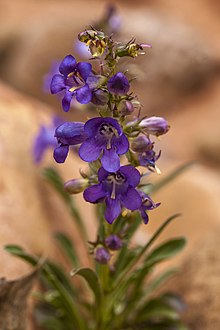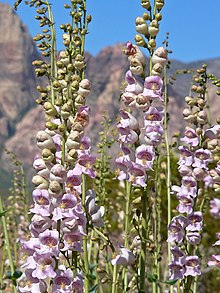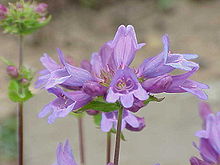Beard thread
| Beard thread | ||||||||||||
|---|---|---|---|---|---|---|---|---|---|---|---|---|
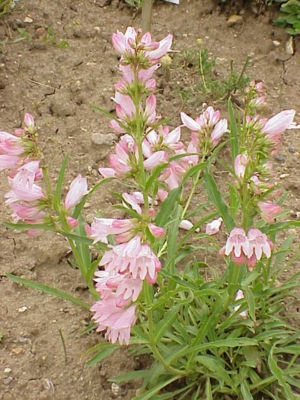
|
||||||||||||
| Systematics | ||||||||||||
|
||||||||||||
| Scientific name | ||||||||||||
| Penstemon | ||||||||||||
| Schmidel |
The Penstemon ( Penstemon ) are a genus within the family of the way Erich plants (Plantaginaceae). With over 250 species, it is a very species-rich genus that is widespread from North to Central America .
description


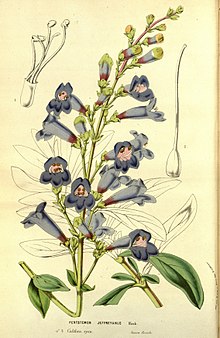


Vegetative characteristics
Most Penstemon TYPES grow as a perennial herbaceous plants , some as half-shrubs or shrubs . Depending on the species, stature heights of 10 centimeters to 3 meters can be reached.
The mostly opposite leaves can be divided into petiole and leaf blade. The uppermost leaves are usually sessile. The simple leaf blade has a smooth to toothed edge.
Generative characteristics
The many showy flowers are grouped in whorls or in paniculate , racemose , zymous inflorescences . The bracts are usually relatively small.
The hermaphrodite flowers are zygomorphic and five-fold with a double flower envelope . The five sepals are fused at their base. The five calyx lobes are ± the same. The five mostly pink to purple or blue, rarely red, yellow or white petals are fused. and can be blue, purple, red, or white. The relatively long corolla tube is ± cylindrical or widened in the lower area. The corolla is two-lipped. The upper lip is bilobed and the lower lip is trilobed. There is only one stamen circle with five stamens. Characteristic is the single conspicuous, backward curved, mostly hairy staminodium that is fused at the base of the corolla tube, hence the German common name "beard thread" of the genus, it is a sterile stamen and often protrudes from the flower. In each flower there are four fertile stamens, which in many species reach the opening of the corolla tube. The stamens, bare at their base, are fused together at different heights in the corolla tubes. The dust bags have two counters and open with two slots. There are two nectar glands at the base of the two upper and rear stamens . The ovary is on top. The stylus ends in a simple scar.
The capsule fruits, which are septicidal and sometimes loculicidal at their upper end , usually contain many seeds. The seeds have irregular edges.
Sets of chromosomes
The basic chromosome number is x = 8. Most of the species examined have diploidy with a chromosome number of 2n = 16; polyploidy was found in a few species .
Locations
The individual species colonize very different habitats - from deserts to swamp forests, and from the sea coasts to the high mountains.

Systematics and distribution
Botanical history and taxonomy
The first Penstemon species was published in 1748 by the American plant collector John Mitchell (1711–1768). It was the species Penstemon laevigatus . Carl von Linné took up this species in 1753 as Chelone pentstemon , although he slightly modified the spelling so that the Greek origin of the word ( penta for five) was easier to recognize. The original spelling Penstemon caught on and was finally accepted as the official generic name. Up until the 20th century, however, the name Pentstemon was occasionally used . The botanical genus name Penstemon is derived from the Greek words pente for five and stemon for stamen. The valid first publication of the generic name Penstemon took place in 1762/1763 by Casimir Christoph Schmidel in Icones Plantarum, Edition Keller . As Lektotypusart was Penstemon pubescens Aiton by Nathaniel Lord Britton and Addison Brown in An Illustrated Flora of the Northern United States , 2nd edition, 3, p 182, 1913 and Francis Whittier Pennell in Contributions from the United States National Herbarium. Smithsonian Institution 20, p. 325, set out in 1920. Synonyms for Penstemon Schmidel are: Pentstemon Aiton orth. Var., Apentostera Raf. , Bartramia Salisb. , Leiostemon Raf. , Leptiris Raf.
In the course of the 18th century and then especially in the 19th century, other Penstemon species were described, all of which were incorporated into the genus Chelone L. by around 1820 . Systematic botanical field studies in the Great Basin increased the number of species to around 250 in the 20th century.
A revision of the genus Penstemon was carried out between 1932 and 1957 by David D. Keck . Since 1946, the American Penstemon Society has dealt with both botany and cultivation issues.
External system
The genus Penstemon was traditionally placed in the families of the figwort plants (Scrophulariaceae) or Veronicaceae. Molecular genetic studies show that the genus Penstemon belongs to the tribe Cheloneae in the plantain family (Plantaginaceae).
Internal system
The genus Penstemon is divided into six sub-genera:
- Penstemon subg. Cryptostemon : It contains only one species: Penstemon personatus Keck
- Penstemon subg. Dasanthera (Raf.) Pennell : It contains about nine species.
- Penstemon subg. Dissecti : It contains only one species: Penstemon dissectus Ell.
- Penstemon subg. Habroanthus Crosswhite : It contains two sections and about 46 species.
- Penstemon subg. Penstemon : It contains eight sections with 22 subsections and about 186 species.
- Penstemon subg. Saccanthera (Benth.) A.Gray : It contains two sections with three subsections and about 26 species.
All Penstemon species originate from the New World (north to Alaska and Canada and east-west from coast to coast). Except for one species that occurs in the highlands of Guatemala , the species occur from North America to southern Mexico. Most of the species come from the western temperate latitudes. Many of the species are only distributed very locally. This is also a reason why there are only relatively few crossbreeds of different species in the wild, and why there are so many Penstemon species ( adaptive radiation ).
The species Pennellianthus frutescens was placed in a separate, monotypical genus Pennellianthus and was placed in the Penstemon as Penstemon frutescens ; it occurs in Japan and in the east of Russia .
There are around 275 types of Penstemon (selection):
- Penstemon abietinus Pennell
- Penstemon absarokensis Evert
- Penstemon acuminatus Dougl. ex Lindl. : It occurs in two varieties in the US states of Washington , Oregon and Nevada .
- Penstemon alamosensis Pennell & Nisbet
- Penstemon albertinus Greene : It occurs in southeastern British Columbia , southwest Alberta , Idaho and western Montana .
- Penstemon albidus Nutt. : It occurs in western Canada and in the western to central United States.
- Penstemon albomarginatus M.E. Jones : It occurs in Arizona , in southeastern California and in southern Nevada .
- Penstemon alluviorum Pennell
- Penstemon alpinus Torr. : It occurs in Colorado and northern New Mexico .
- Penstemon ambiguus Torr. : It is found in two varieties in the western and central United States and in the northern part of the Mexican state of Chihuahua .
- Penstemon ammophilus N.H. Holmgren & LMSchultz : It is only found in Utah .
- Penstemon anguineus Eastw. : It occurs in Oregon and northwestern California.
- Penstemon angustifolius Nutt. ex Pursh : It occurs in two varieties in the western to central United States.
- Penstemon apateticus Straw : It occurs in Mexico.
- Penstemon arenarius Greene
- Penstemon arenicola A. Nelson : It occurs in Wyoming and Utah.
- Penstemon aridus Rydb.
- Penstemon arkansanus Pennell
- Penstemon attenuatus Dougl. ex Lindl. : It occurs in the northwestern United States.
- Penstemon atwoodii Welsh
- Penstemon auriberbis Pennell : It occurs in southeastern Colorado and northeastern New Mexico.
- Penstemon australis Small : It is found in the southeastern United States.
- Penstemon azureus Benth. : It occurs in two varieties in southwest Oregon and northern California.
- Penstemon baccharifolius Hook. : It occurs in Texas and the Mexican state of Coahuila .
- Penstemon barbatus (Cav.) Roth : It occurs in two varieties in Colorado, New Mexico, Texas, Arizona, Utah, and northern Mexico.
- Penstemon barnebyi N.Holmgren
- Penstemon barrettiae A.Gray : It occurs in Oregon and Washington.
- Penstemon bicolor (Brandeg.) Clokey & DDKeck : It occurs in two varieties in northwestern Arizona, in southeastern California and in southwestern Nevada.
- Penstemon bracteatus Keck
- Penstemon breviculus (Keck) Nisbet & RCJackson
- Penstemon bryantiae Keck
- Penstemon buckleyi Pennell : It occurs in the western to central United States.
- Penstemon caesius A. Gray
- Penstemon caespitosus Nutt. ex A.Gray : It occurs in northwestern Colorado, in southern Wyoming , in northeastern Arizona and in Utah.
- Penstemon calcareus Brandeg.
- Penstemon californicus (Munz & Johnston) Keck
- Penstemon calycosus Small : It is found in Illinois and the eastern United States.
- Penstemon campanulatus (Cav.) Willd. (Syn .: Penstemon pulchellus Lindl. ): It is distributed from northern to southern Mexico.
- Penstemon canescens (Britt.) Britt. : It occurs in the eastern United States.
- Penstemon cardinalis Woot. & Standl.
- Penstemon cardwellii T.J.Howell : It occurs in western Oregon and southwestern Washington in.
- Penstemon carnosus Pennell : It is only found in Utah.
- Penstemon Caryi Pennell
- Penstemon cedrosensis Kellogg : This endemic occurs only on the Isla de Cedros off the Pacific coast of the Baja California peninsula and belongs to the Mexican state of Baja California.
- Penstemon centranthifolius (Benth.) Benth. : It occurs only from California to the Mexican state of Baja California .
- Penstemon cinicola D.D. Keck : It occurs in Oregon and northeastern California.
- Penstemon clevelandii A. Gray
- Penstemon clutei A. Nelson : It only occurs in Arizona.
- Penstemon cobaea Nutt.
- Penstemon comarrhenus A.Gray : It occurs in southwestern Colorado, northeastern Arizona, Nevada and Utah.
- Penstemon compactus (DDKeck) Crosswhite : Found in Idaho and northern Utah.
- Penstemon concinnus D.D. Keck
- Penstemon confertus Dougl. ex Lindl. : It occurs in southwest Alberta , southeast British Columbia, Idaho, western Montana, northeast Oregon and Washington.
- Penstemon confusus M.E. Jones : It occurs in Nevada and Utah.
- Penstemon crandallii A. Nels. : It occurs in Colorado, New Mexico and Utah.
- Penstemon crideri A. Nels .
- Penstemon cusickii A.Gray : It occurs in southwest Idaho and Oregon.
- Penstemon cyananthus Hook. : It occurs in two varieties in Idaho, Wyoming, and Utah.
- Penstemon cyaneus Pennell : It occurs in Idaho, Montana and Wyoming.
- Penstemon cyanocaulis Payson : It occurs in Colorado and Utah.
- Penstemon cyathophorus Rydb. : It occurs in Colorado and Wyoming.
- Penstemon dasyphyllus A. Gray
- Penstemon davidsonii Greene : It is distributed in western North America from southern British Columbia via Oregon, Washington and northern Nevada to California.
- Penstemon deamii Pennell
- Penstemon deaveri Crosswhite
- Penstemon debilis O'Kane & J.Anderson : It only occurs in Colorado.
- Penstemon degeneri Crosswhite : It is only found in Colorado.
- Penstemon deustus Dougl. ex Lindl. : It occurs in two varieties in the western United States.
- Penstemon digitalis Nutt. ex Sims : It occurs in the central to eastern United States.
- Penstemon diphyllus Rydb.
- Penstemon discolor cheeky
- Penstemon dissectus Elliott : This endemic occurs only in southern Georgia .
- Penstemon distans N.Holmgren
- Penstemon dolius M.E. Jones ex Pennell : It occurs in Nevada and Utah.
- Penstemon dubius A David.
- Penstemon eatonii A.Gray : It occurs in two varieties in Colorado, New Mexico, Arizona, California, Nevada, and Utah.
- Penstemon elegantulus Pennell
- Penstemon ellipticus J.M. Coult. & Fisher : It occurs in southeastern British Columbia, southwestern Alberta, Idaho and western Montana.
- Penstemon eriantherus Pursh : It occurs in four varieties in Alberta, British Columbia, Washington, Oregon, Wyoming , Montana , Idaho, Colorado, Nebraska , North Dakota and South Dakota .
- Penstemon euglaucus English : It occurs in southwest Washington and northwest Oregon.
- Penstemon eximius Keck
- Penstemon fendleri Torr. & A.Gray : It is found in southwestern Kansas, western Oklahoma , New Mexico, Texas, and eastern Arizona.
- Penstemon filiformis (Keck) Keck
- Penstemon flavescens Pennell
- Penstemon floribundus D. Danley
- Penstemon floridus Brandeg. : It occurs in two varieties in California and Nevada.
- Penstemon flowersii Neese & Welsh
- Penstemon franklinii Welsh
- Penstemon Fremontii Torr. & A.Gray ex A.Gray : It occurs in northwestern Colorado, in southwestern Wyoming and in northeastern Utah.
- Penstemon frutescens Lamb. : It occurs in Russia's Far East , on the Kuril Islands and on the Japanese islands of Hokkaido and northern Honshu .
- Penstemon fruticiformis Coville
- Penstemon fruticosus (Pursh) Greene : It occurs in British Columbia, Idaho, Montana, Wyoming, Washington and Oregon. Scouler's beard thread ( Penstemon fruticosus (Pursh) Greene var. Scouleri (Lindl.) Cronquist , Syn .: Penstemon scouleri Lindl. )Also belongs to this species .
- Penstemon gairdneri Hook. : It occurs in two varieties in Idaho, eastern Washington and eastern Oregon.
- Penstemon gentianoides (Kunth) Poir. : It occurs in Mexico and Guatemala .
- Penstemon gibbensii thorn : It only occurs in Wyoming.
- Penstemon glaber Pursh : It occurs in two varieties in Wyoming, Colorado, New Mexico, Nebraska, North Dakota and South Dakota.
- Penstemon glandulosus Douglas ex Lindl. : It occurs in southeast Washington, northeast Oregon, and western Idaho.
- Penstemon glaucinus Pennell
- Penstemon globosus (Piper) Pennell & Keck
- Penstemon goodrichii N.Holmgren
- Penstemon gormanii Greene : It occurs in Alaska and Canada.
- Penstemon gracilentus A. Gray
- Penstemon gracilis Nutt. : It occurs in Canada and the central to western United States.
- Penstemon grahamii D.D. Keck : It occurs in Colorado and Utah.
- Penstemon grandiflorus Nutt. : It occurs in the northern United States, Texas, and New Mexico.
- Penstemon griffinii A. Nelson
- Penstemon grinnellii Eastw. : The two varieties are only found in southern California.
- Penstemon guadalupensis A. Heller
- Penstemon hallii Gray
- Penstemon harbourii A. Gray
- Penstemon harringtonii Penland : It is only found in Colorado.
- Penstemon hartwegii Benth. : It only occurs in the Mexican state of Hidalgo .
- Penstemon havardii A.Gray : It is only found in Texas.
- Penstemon haydenii S. Watson : It only occurs in Nebraska .
- Penstemon heterodoxus A.Gray : The three varieties occur in California and western Nevada.
- Penstemon heterophyllus Lindl. : The three varieties are only found in California.
- Penstemon hirsutus (L.) Willd. : It occurs from eastern Canada to the central and eastern United States.
- Penstemon humilis Nutt. ex A.Gray : It occurs in three varieties in the western United States.
- Penstemon idahoensis N.D. Atwood & SLWelsh : It is found in Idaho and Utah.
- Penstemon immanifestus N.H.Holmgren : It occurs in Nevada and Utah.
- Penstemon incertus Brandeg. : It occurs in southern California.
- Penstemon inflatus Crosswhite
- Penstemon jamesii Benth. : It occurs in Colorado, Kansas, Arizona, New Mexico and Texas.
- Penstemon janishiae N.H.Holmgren : It comes in northern California, Oregon, Idaho and Nevada before.
- Penstemon Jonesii Pennell
- Penstemon kingii S. Watson
- Penstemon kunthii G. Don : It occurs in Mexico.
- Penstemon labrosus (A. Gray) Hook. : It occurs from southern California to Mexico.
- Penstemon laetus A.Gray : The three varieties occur in Oregon and California.
- Penstemon laevigatus Ait. : It occurs in the eastern United States.
- Penstemon laevis Pennell : It occurs in Arizona and Utah.
- Penstemon laricifolius Hook. & Arn. : It occurs in two varieties in northern Colorado and Wyoming.
- Penstemon laxiflorus Pennell : It occurs in Oklahoma , Alabama , Arkansas , Georgia , Louisiana , Mississippi , Florida and in eastern Texas.
- Penstemon laxus A. Nelson
- Penstemon leiophyllus Pennell : It occurs in Nevada and Utah.
- Penstemon lemhiensis (Keck) Keck & Cronq.
- Penstemon lentus Pennell : It occurs in southwestern Colorado, northeastern Arizona and southeastern Utah.
- Penstemon leonardii Rydb. : It occurs in southeast Idaho and Utah. There are two varieties.
- Penstemon leptanthus Pennell
- Penstemon linarioides A.Gray : There are about three subspecies. They are found in southwest Colorado, western New Mexico, Arizona, Nevada, and Utah.
- Penstemon longiflorus (Pennell) SLClark : It is found in Utah.
- Penstemon lyallii (A.Gray) A.Gray : It is found in British Columbia, Alberta, Idaho, Montana and Washington.
- Penstemon marcusii (Keck) N.Holmgren
- Penstemon mensarum Pennell : It occurs in Colorado.
- Penstemon mirus A. Nelson
- Penstemon miser gray
- Penstemon moffatii Eastw.
- Penstemon monoensis A.Heller : It occurs in California.
- Penstemon montanus Greene
- Penstemon moriahensis N.Holmgren
- Penstemon multiflorus Chapman ex Benth. : It occurs in Florida and southern Georgia.
- Penstemon murcronatus N. Holmgr .
- Penstemon murrayanus Hook. : It occurs in Oklahoma, Arkansas, Louisiana, and eastern Texas.
- Penstemon nanus D.D. Keck : It occurs in Utah.
- Penstemon navajoa N. Holmgren
- Penstemon neomexicanus Woot. & Standl.
- Penstemon neotericus D.D. Keck : It only occurs in California.
- Penstemon newberryi A.Gray : The three varieties occur in Oregon, Nevada and California.
- Penstemon nitidus Dougl. ex Benth. : It occurs in British Columbia, Alberta, Saskachewan, Manitoba, Washington, Montana, Idaho, Wyoming and North Dakota.
- Penstemon nudiflorus A. Gray : It is only found in Arizona.
- Penstemon oklahomensis Pennell
- Penstemon oliganthus Woot. & Standl.
- Penstemon ophianthus Pennell : It occurs in southwestern Colorado, northwestern New Mexico, in northern Arizona and in Utah.
- Penstemon osterhoutii Pennell : It only occurs in Colorado.
- Penstemon ovatus Douglas : It occurs in southern British Columbia, Washington and northern Oregon.
- Penstemon pachyphyllus A. Gray ex Rydb. : There are three varieties. They are found in Colorado, Wyoming, Nevada, Utah, and northern Arizona.
- Penstemon pahutensis N.Holmgren : This endemic is found only in the Grapevine Mountains of California.
- Penstemon pallidus Small : It is found in the north-central and eastern United States.
- Penstemon palmeri A.Gray : There are three varieties. They occur in Arizona, California, Nevada and Utah.
- Penstemon papillatus J.T. Howell : It is only found in California.
- Penstemon parishii A. Gray
- Penstemon parryi (A.Gray) A.Gray : It is found in Arizona and the Mexican state of Sonora .
- Penstemon parviflorus Pennell
- Penstemon parvulus (A.Gray) Krautter : It occurs in California and Oregon.
- Penstemon parvus Pennell
- Penstemon patens (MEJones) N.Holmgren : It is found in California and southern Nevada.
- Penstemon payettensis A. Nels . & JFMacbr. : It occurs in Idaho and northeastern Oregon.
- Penstemon paysoniorum Keck
- Penstemon peckii Pennell
- Penstemon peirsonii Munz & IMJohnston
- Penstemon penlandii W.A. Weber : It is only found in Colorado.
- Penstemon pennellianus D.D. Keck : It occurs in Oregon and southeast Washington.
- Penstemon perpulcher A. Nelson
- Penstemon personatus Keck : It only occurs in California.
- Penstemon petiolatus Brandeg.
- Penstemon pinifolius Greene
- Penstemon pinorum L.H. & JSShultz : This endemic is only found in southwestern Utah.
- Penstemon platyphyllus Rydb. : It only occurs in Utah.
- Penstemon pratensis Greene : It occurs in southwestern Idaho, in southeastern Oregon and in northern Nevada.
- Penstemon procerus Dougl. ex Graham : The four varieties are widespread in western North America. It iswidespreadfrom Alaska through the Yukon Territory and the western Canadian provinces of Alberta , British Columbia, Manitoba and southwestern Saskatchewan to the western US states of Oregon, Washington, Colorado, Montana , Wyoming , Nevada, Utah and California.
- Penstemon pruinosus Douglas ex Lindl. : It occurs in southern British Columbia and northern Washington.
- Penstemon pseudoparvus Crosswhite
- Penstemon pseudoputus (Crosswhite) N. Holmgren
- Penstemon pseudospectabilis M.E.Jones : There are two subspecies. They occur in southeastern California and Arizona.
- Penstemon pudicus Reveal & Beatley
- Penstemon pumilus Nutt. : It only occurs in Idaho.
- Penstemon purpusii Brandeg. : It occurs in California.
- Penstemon putus A.Nelson
- Penstemon radicosus A.Nelson
- Penstemon ramosus Crosswhite
- Penstemon rattanii A.Gray : The two varieties occur in Oregon and California.
- Penstemon retrorsus Payson ex Pennell
- Penstemon retrosus Payson ex Pennell
- Penstemon rhizomatosus N.Holmgren
- Penstemon richardsonii Douglas ex Lindl. : There are three varieties. They occur in southern British Columbia, Washington, and Oregon.
- Penstemon roezlii rule : It occurs in Oregon, California and Nevada.
- Penstemon rostriflorus Kellogg (Syn .: Penstemon bridgesii A.Gray :) It occurs in southwestern Colorado, in northwestern New Mexico, in northern Arizona, in eastern California, in southern Nevada and in southern Utah.
- Penstemon rubicundus D.D. Keck : It is only found in Nevada.
- Penstemon rupicola ( Piper) TJHowell : It occurs in western Oregon, western Washington and northwestern California.
- Penstemon rydbergii A. Nelson : There are two varieties. They are found in southeast Washington, Oregon, Wyoming, Idaho, southwest Montana, Nevada, Utah, northern Arizona, eastern California, and northern New Mexico.
- Penstemon saxosorum Pennell
- Penstemon scapoides D.D.Keck : This endemic is only in the Last Chance chain in California.
- Penstemon scariosus Pennell : There are three varieties. They occur in Colorado and Utah.
- Penstemon secundiflorus Benth. : It occurs in eastern Colorado, southeastern Wyoming, and northeastern New Mexico.
- Penstemon seorsus (A.Nelson) DD Keck
- Penstemon sepalulus A.Nelson : only occurs in Utah.
- Penstemon serrulatus Menzies ex Sm . : It occurs in southeast Alaska, southern British Columbia, western Washington and western Oregon.
- Penstemon smallii A.Heller : It is found in northeast Georgia, southeast Kentucky, western North Carolina, northwest South Carolina, and eastern Tennessee.
- Penstemon spatulatus Pennell
- Penstemon speciosus Douglas ex Lindl. : It occurs in Washington, Oregon, southwest Idaho, western Utah, California, and Nevada.
- Penstemon spectabilis Thurb. ex A.Gray : The two varieties occur from California to Mexico.
- Penstemon stenophyllus (A.Gray) TJHowell
- Penstemon stephensii Brandeg. : This endemic occurs only in southeastern California.
- Penstemon strictiformis Rydb. : It occurs in southwest Colorado, northwest New Mexico, northeast Arizona and Utah.
- Penstemon strictus Benth. : It occurs in western Colorado, Wyoming, New Mexico, Utah and northeastern Arizona.
- Penstemon subglaber Rydb. : It occurs in southeastern Idaho, western Wyoming, and northeastern Utah.
- Penstemon subserratus Pennell
- Penstemon subulatus M.E. Jones
- Penstemon sudan M.E.Jones : It occurs in Nevada and California.
- Penstemon superbus A. Nelson : It occurs in southeastern Arizona, New Mexico and the Mexican state of Chihuahua.
- Penstemon tenuiflorus Pennell
- Penstemon tenuis Small
- Penstemon teucrioides Greene
- Penstemon thompsoniae (Gray) Rydb. : It occurs in Utah, Arizona and in California in the New York Mountains and in the Clark Mountain Range.
- Penstemon thurberi Torr. : It occurs in Arizona, New Mexico, southern Nevada, southeastern California, and northern Mexico.
- Penstemon tidestromii Pennell
- Penstemon tiehmii N.Holmgren
- Penstemon tracyi D.D.Keck : This endemic is only the northern part of Trinity County before in northern California.
- Penstemon triflorus A. Heller
- Penstemon triphyllus Douglas : It occurs in Idaho, northeast Oregon and southeast Washington.
- Penstemon tubiflorus Nutt. : It occurs in the central and eastern United States.
- Penstemon tusharensis N.Holmgren
- Penstemon uintahensis Pennell
- Penstemon unilateralis Rydb. : It occurs in Colorado and southern Wyoming.
- Penstemon utahensis Eastw. : It occurs in Utah, Nevada and in southeastern California.
- Penstemon venustus Douglas ex Lindl. : It is originally found in Washington, Oregon and Idaho and is a neophyte in Utah and California.
- Penstemon virens Pennell ex Rydb. : It occurs in Colorado and Wyoming.
- Penstemon virgatus A.Gray : It occurs in Arizona and New Mexico.
- Penstemon wardii A. Gray
- Penstemon washingtonensis D.D. Keck
- Penstemon watsonii A.Gray : It occurs in Nevada, Utah, northwestern Colorado, southwestern Idaho, and southwestern Wyoming.
- Penstemon whippleanus A.Gray : It is found in Colorado, Wyoming, southeast Idaho, southwest Montana, New Mexico, Utah, and northern Arizona.
- Penstemon wilcoxii Rydb. : It occurs in Idaho, northwestern Montana, northeastern Oregon, and Washington.
- Penstemon wrightii hook.
- Penstemon yampaensis Penl. (Syn .: Penstemon acaulis var. Yampaensis (Penl.) Neese ): It occurs in Colorado and in a county in Utah.
use
As a medicinal plant
Some North American Indian tribes used types of beard thread for toothache.
As an ornamental plant
Many varieties are used as ornamental plants in parks and gardens.
Although it is a purely North American genus, the breeding of new varieties was mainly carried out in Europe . As early as the beginning of the 19th century, seeds of various types of beard thread were offered for sale there. The first hybrids were created at this time .
Breeding activities intensified, especially in the 1860s. Breeds by Victor Lemoine and Wilhelm Pfitzer deserve special mention here . The Scottish John Forbes company offered 180 varieties in 1870. By 1900 it became the world's leading breeding company for beard thread species with 550 varieties, closely followed by Lemoine with 470 varieties.
swell
- Margriet Wetherwax, Noel H. Holmgren, 2012: In: Jepson Flora Project (eds.): Jepson eFlora , Penstemon , last accessed on December 6, 2018.
literature
- Francis Whittier Pennell: The Scrophulariaceae of Eastern Temperate North America . In: Monographs / The Academy of natural sciences of Philadelphia . tape 1 . Academy of Natural Sciences, 1935, ISBN 978-1-4223-1790-7 , pp. 650 ( Penstemon from page 196 in the Google book search).
- Andrea D. Wolfe, Christopher P. Randle, Shannon L. Datwyler, Jeffery J. Morawetz, Nidia Arguedas, Jose Diaz: Phylogeny, taxonomic affinities, and biogeography of Penstemon (Plantaginaceae) based on ITS and cpDNA sequence data. In: American Journal of Botany Volume 93, Issue 11, 2006, pp. 1699-1713. Full text PDF.
- David Way, Peter James: The Gardener's Guide to Growing Penstemons. David & Charles Publishers, 1998, ISBN 0-7153-0550-6 .
- Shaun R. Broderick: An Examination of the DNA Content, Taxonomy and Phylogeny of Penstemon (Plantaginaceae). A thesis submitted to the faculty of Brigham Young University in partial fulfillment of the requirements for the degree of Master of Science, 2010. PDF.
Individual evidence
- ↑ a b c d e f g h i j k l m n o p q r s t u v w x y z aa ab ac ad ae af ag ah ai aj Margriet Wetherwax, Noel H. Holmgren, 2012: In: Jepson Flora Project (eds.): Jepson eFlora , Penstemon , last accessed December 6, 2018.
- ↑ Shaun R. Broderick: An Examination of the DNA Content, Taxonomy and Phylogeny of Penstemon (Plantaginaceae). A thesis submitted to the faculty of Brigham Young University in partial fulfillment of the requirements for the degree of Master of Science, 2010. PDF.
- ↑ a b Penstemon at Tropicos.org. Missouri Botanical Garden, St. Louis, accessed December 16, 2017.
- ↑ a b c d e f g h i j k l m n o p q r s t u v w x y z aa ab ac ad ae af ag ah ai aj ak al am an ao ap aq ar as at au av aw ax ay az ba bb bc bd be bf bg bh bi bj bk bl bm bn bo bp bq br bs bt bu bv bw bx by bz ca cb cc cd ce cf cg ch ci cj ck cl cm cn co cp cq cr cs ct cu cv cw cx cy cz da db dc dd de df dg dh di dj dk dl dm dn do dp dq dr ds dt du dv dw dx dy dz ea eb ec ed ee ef eg eh ei ej ek el em en eo ep eq er Penstemon in the Germplasm Resources Information Network (GRIN), USDA , ARS , National Genetic Resources Program. National Germplasm Resources Laboratory, Beltsville, Maryland.
- ^ The Penstemon Website, by Andrea D. Wolfe (updates to 2000). ( Memento of the original from October 9, 2006 in the Internet Archive ) Info: The archive link was inserted automatically and has not yet been checked. Please check the original and archive link according to the instructions and then remove this notice.
- ↑ Botany Online : Kinship, Species Bastards, Adaptive Radiation .
- ↑ Urania plant kingdom . Volume 4: Flowering Plants , 2, 1st edition, Urania-Verlag, Leipzig 1994, ISBN 3-332-00497-2 .
Web links
- Penstemon at Tropicos.org. In: IPCN Chromosome Reports . Missouri Botanical Garden, St. Louis
- Penstemon at Tropicos.org. In: Flora of Missouri . Missouri Botanical Garden, St. Louis
- Penstemon at Tropicos.org. In: Flora Mesoamericana . Missouri Botanical Garden, St. Louis
- Data sheet Penstemon at USDA .
- The genus Penstemon at Colorado Native Plant Society - PDF. ( Page no longer available , search in web archives: The genus Penstemon )
- Datasheet Penstemon In: Klinkenberg, Brian. (Editor) 2018. E-Flora BC: Electronic Atlas of the Flora of British Columbia = E-Flora BC, Lab for Advanced Spatial Analysis, Department of Geography, University of British Columbia, Vancouver.





